Effect of Annealing Process on Interface Behavior of Al/Zn Laminated Composites
Abstract
1. Introduction
2. Materials and Methods
2.1. Materials
2.2. Preparation of Al/Zn Laminated Composite Plate
2.3. Material Characterization
3. Results and Discussion
3.1. Observation of Interface Morphology
3.2. Microstructure of Al/Zn Composite Plate
3.3. Growth Dynamics Analysis of Interfacial Diffusion Layer
3.4. Mechanical Properties
4. Conclusions
Author Contributions
Funding
Institutional Review Board Statement
Informed Consent Statement
Data Availability Statement
Acknowledgments
Conflicts of Interest
References
- Lu, K.; Lu, L.; Suresh, S. Strengthening Materials by Engineering Coherent Internal Boundaries at the Nanoscale. Science 2009, 324, 349–352. [Google Scholar] [CrossRef] [PubMed]
- Kou, H.; Lu, J.; Li, Y. High-Strength and High-Ductility Nanostructured and Amorphous Metallic Materials. Adv. Mater. 2014, 26, 5518–5524. [Google Scholar] [CrossRef] [PubMed]
- Mara, N.; Bhattacharyya, D.; Hoagland, R.; Misra, A. Tensile behavior of 40 nm Cu/Nb nanoscale multilayers. Scr. Mater. 2008, 58, 874–877. [Google Scholar] [CrossRef]
- Bhattacharyya, D.; Mara, N.A.; Dickerson, P.; Hoagland, R.G.; Misra, A. Compressive flow behavior of Al-TiN multilayers at nanometer scale layer thickness. Acta. Mater. 2011, 59, 3804–3816. [Google Scholar] [CrossRef]
- Mara, N.A.; Bhattacharyya, D.; Dickerson, P.; Hoagland, R.G.; Misra, A. Deformability of ultrahigh strength 5nm Cu∕Nb nanolayered composites. Appl. Phys. Lett. 2008, 92, 231901. [Google Scholar] [CrossRef]
- Cui, Y.; Huang, P.; Wang, F.; Lu, T.; Xu, K. The hardness and related deformation mechanisms in nanoscale crystalline–amorphous multilayers. Thin Solid Films 2015, 584, 270–276. [Google Scholar] [CrossRef]
- Tayyebi, M.; Eghbali, B. Study on the microstructure and mechanical properties of multilayer Cu/Ni composite processed by accumulative roll bonding. Mater. Sci. Eng. A 2013, 559, 759–764. [Google Scholar] [CrossRef]
- Izadi, S.; Mraied, H.; Cai, W. Tribological and mechanical behavior of nanostructured Al/Ti multilayers. Surf. Coat. Technol. 2015, 275, 374–383. [Google Scholar] [CrossRef]
- Wei, A.-L.; Liu, X.-H.; Dong, L.; Liang, W. Binding property of Al/Mg/Al thin plates fabricated by one-pass hot rolling with different reduction ratios, temperatures and annealing treatments. Rare Met. 2015, 37, 136–142. [Google Scholar] [CrossRef]
- Feng, B.; Sun, Z.; Wu, Y.; Feng, X.; Wang, J.; Zheng, K. Microstructure and mechanical behavior of Mg ZK60/Al 1100 composite plates fabricated by co-extrusion. J. Alloys. Compd. 2020, 842, 155676. [Google Scholar] [CrossRef]
- Yu, S.J.; Chen, Z.F.; Wang, Y.; Luo, R.Y.; Xu, T.Z.; Pan, Y.; Liao, J.H. Fabrication of SiC/diamond composite coatings by electrophoretic deposition and chemical vapor deposition. Int. J. Appl. Ceram. Tec. 2017, 14, 644–651. [Google Scholar] [CrossRef]
- Xie, Y.C.; Chen, C.Y.; Planche, M.; Deng, S.H.; Liao, H.L. Effect of spray angle on Ni particle deposition be-haviour in cold spray, Surf. Eng. 2018, 34, 352–360. [Google Scholar]
- Spalek, N.; Brunow, J.; Braun, M.; Rutner, M. WAAM-Fabricated Laminated Metal Composites. Metals 2021, 11, 1948. [Google Scholar] [CrossRef]
- Wang, J.; Zhang, X.J.; Lu, X.; Yang, Y.S.; Wang, Z.H. Microstructure, texture and mechanical properties of hot-rolled Mg–4Al–2Sn–0.5Y–0.4Nd alloy. J. Magnes. Alloy. 2016, 4, 207–213. [Google Scholar] [CrossRef]
- Kodetová, V.; Vlach, M.; Kudrnová, H.; Leibner, M.; Málek, J.; Cieslar, M.; Bajtošová, L.; Harcuba, P.; Neubert, V. Annealing effects in commercial aluminium hot-rolled 7075(–Sc–Zr) alloys. J. Therm. Anal. Calorim. 2020, 142, 1613–1623. [Google Scholar] [CrossRef]
- Du, Y.; Fan, G.; Yu, T.; Hansen, N.; Geng, L.; Huang, X. Laminated Ti-Al composites: Processing, structure and strength. Mater. Sci. Eng. A 2016, 673, 572–580. [Google Scholar] [CrossRef]
- Kulagin, R.; Beygelzimer, Y.; Ivanisenko, Y.; Mazilkin, A.; Straumal, B.; Hahn, H. Instabilities of interfaces between dissimilar metals induced by high pressure torsion. Mater. Lett. 2018, 222, 172–175. [Google Scholar] [CrossRef]
- Ren, Y.; Tariq, N.U.H.; Liu, H.; Cui, X.; Shen, Y.; Wang, J.; Xiong, T. An innovative and flexible approach to fabricate Mg/Al composite plates: Cold spraying and hot rolling post-treatment. Mater. Sci. Eng. A 2022, 849, 143515. [Google Scholar] [CrossRef]
- Liu, H.; Zhang, B.; Zhang, G. Enhanced toughness and fatigue strength of cold roll bonded Cu/Cu laminated composites with mechanical contrast. Scr. Mater. 2011, 65, 891–894. [Google Scholar] [CrossRef]
- Liu, H.; Zhang, B.; Zhang, G. Delaying premature local necking of high-strength Cu: A potential way to enhance plasticity. Scr. Mater. 2011, 64, 13–16. [Google Scholar] [CrossRef]
- Li, L.; Nagai, K.; Yin, F. Progress in cold roll bonding of metals. Sci. Technol. Adv. Mater. 2008, 9, 023001. [Google Scholar] [CrossRef] [PubMed]
- Pintore, M.; Wölck, J.; Mittler, T.; Greß, T.; Tonn, B.; Volk, W. Composite Casting and Characterization of Cu–Al Bilayer Compounds. Int. J. Met. 2019, 14, 155–166. [Google Scholar] [CrossRef]
- Li, X.; Scherf, A.; Heilmaier, M.; Stein, F. The Al-Rich Part of the Fe-Al Phase Diagram. J. Phase Equilibria Diffus. 2016, 37, 162. [Google Scholar] [CrossRef]
- Li, L.L.; Su, Y.Q.; Beyerlein, I.J.; Han, W.Z. Achieving room-temperature brittle-to-ductile transition in ultrafine layered Fe-Al alloys. Sci. Adv. 2020, 6, eabb6658. [Google Scholar] [CrossRef]
- Guo, X.Z.; Fan, M.Y.; Liu, Z.L. Explosive Cladding and Hot Pressing of Ti/Al/Ti Laminates. Rare. Metal. Mat. Eng. 2017, 46, 1192–1196. [Google Scholar]
- Hallal, A.; Shaito, A.; Elmarakbi, A. Advanced Composite Materials for Automotive Applications: Structural Integrity and Crashworthiness; Wiley: Hoboken, NJ, USA, 2013. [Google Scholar]
- Bhoi, N.K.; Singh, H.; Pratap, S. Developments in the aluminum metal matrix composites reinforced by micro/nano particles–a review. J. Compos. Mater. 2020, 54, 813–833. [Google Scholar] [CrossRef]
- Qods, R.N.D.F.; Tajally, M. Investigation on microstructure and mechanical properties of Al–Zn composite during accumulative roll bonding (ARB) process. Mat. Sci. Eng. A 2011, 530, 63–72. [Google Scholar]
- Dehsorkhi, R.N.; Qods, F.; Tajally, M. Application of continual annealing and roll bonding (CAR) process for manufacturing Al–Zn multilayered composites. Mater. Sci. Eng. A 2012, 549, 206–212. [Google Scholar] [CrossRef]
- Zhang, C.Q.; Liu, W. Abnormal effect of temperature on intermetallic compound layer growth at aluminum-titanium interface. Mater. Lett. 2019, 254, 1–4. [Google Scholar] [CrossRef]
- Zhao, Z.; Tang, J.; Tariq, N.U.H.; Liu, H.; Liu, H.; Ren, Y.; Tong, M.; Yin, L.; Du, H.; Wang, J.; et al. Effect of rolling temperature on microstructure and mechanical properties of Ti/steel clad plates fabricated by cold spraying and hot-rolling. Mater. Sci. Eng. A 2020, 795, 139982. [Google Scholar] [CrossRef]
- Qiu, X.; Qi, L.; Tang, J.-R.; Tariq, N.U.H.; Wang, J.-Q.; Xiong, T.-Y. A viable approach to repair neutron shielding B4C/6061 Al composite sheets through cold spray and hot rolling co-treatment. J. Mater. Sci. Technol. 2021, 106, 173–182. [Google Scholar] [CrossRef]
- Sauvage, X.; Dinda, G.P.; Wilde, G. Non-equilibrium intermixing and phase transformation in severely de-formed Al/Ni multilayers. Scripta. Mater. 2007, 56, 181–184. [Google Scholar] [CrossRef]
- Yu, H.; Lu, C.; Tieu, A.K.; Li, H.; Godbole, A.; Kong, C. Annealing effect on microstructure and mechanical properties of Al/Ti/Al laminate sheets. Mater. Sci. Eng. A 2016, 660, 195–204. [Google Scholar] [CrossRef]
- Chen, Z.; Wang, D.; Cao, X.; Yang, W.; Wang, W. Influence of multi-pass rolling and subsequent annealing on the interface microstructure and mechanical properties of the explosive welding Mg/Al composite plates. Mater. Sci. Eng. A 2018, 723, 97–108. [Google Scholar] [CrossRef]
- Macwan, A.; Jiang, X.Q.; Li, C.; Chen, D.L. Effect of annealing on interface microstructures and tensile properties of rolled Al/Mg/Al tri-layer clad sheets. Mater. Sci. Eng. A. 2013, 587, 344–351. [Google Scholar] [CrossRef]
- Zhang, C.; Wang, S.; Qiao, H.; Chen, Z.; Mo, T.; Liu, Q. Enhancing the Mechanical Properties of Hot Roll Bonded Al/Ti Laminated Metal Composites (LMCs) by Pre-Rolling Diffusion Process. Metals 2019, 9, 795. [Google Scholar] [CrossRef]
- Jamaati, R.; Toroghinejad, M.R. Investigation of the parameters of the cold roll bonding (CRB) process. Mater. Sci. Eng. A 2010, 527, 2320–2326. [Google Scholar] [CrossRef]
- Qiu, X.; Tariq, N.U.; Qi, L.; Zan, Y.N.; Wang, Y.J.; Wang, J.Q.; Du, H.; Xiong, T.Y. In-situ Si-p/A380 alloy nano micro composite formation through cold spray additive manufacturing and subsequent hot rolling treatment: Microstructure and mechanical properties. J. Alloys Compd. 2019, 780, 597–606. [Google Scholar] [CrossRef]
- Feng, B.; Xin, Y.; Sun, Z.; Yu, H.; Wang, J.; Liu, Q. On the rule of mixtures for bimetal composites. Mater. Sci. Eng. A 2017, 704, 173–180. [Google Scholar] [CrossRef]
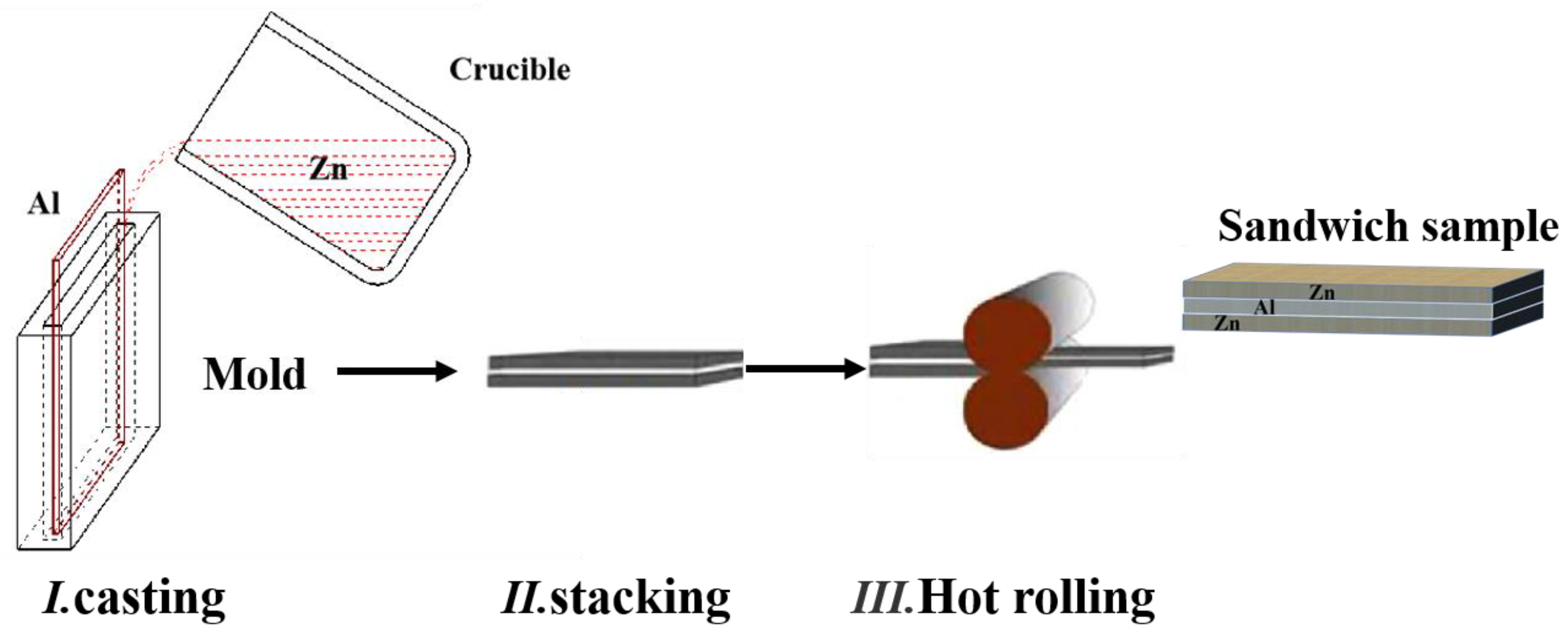
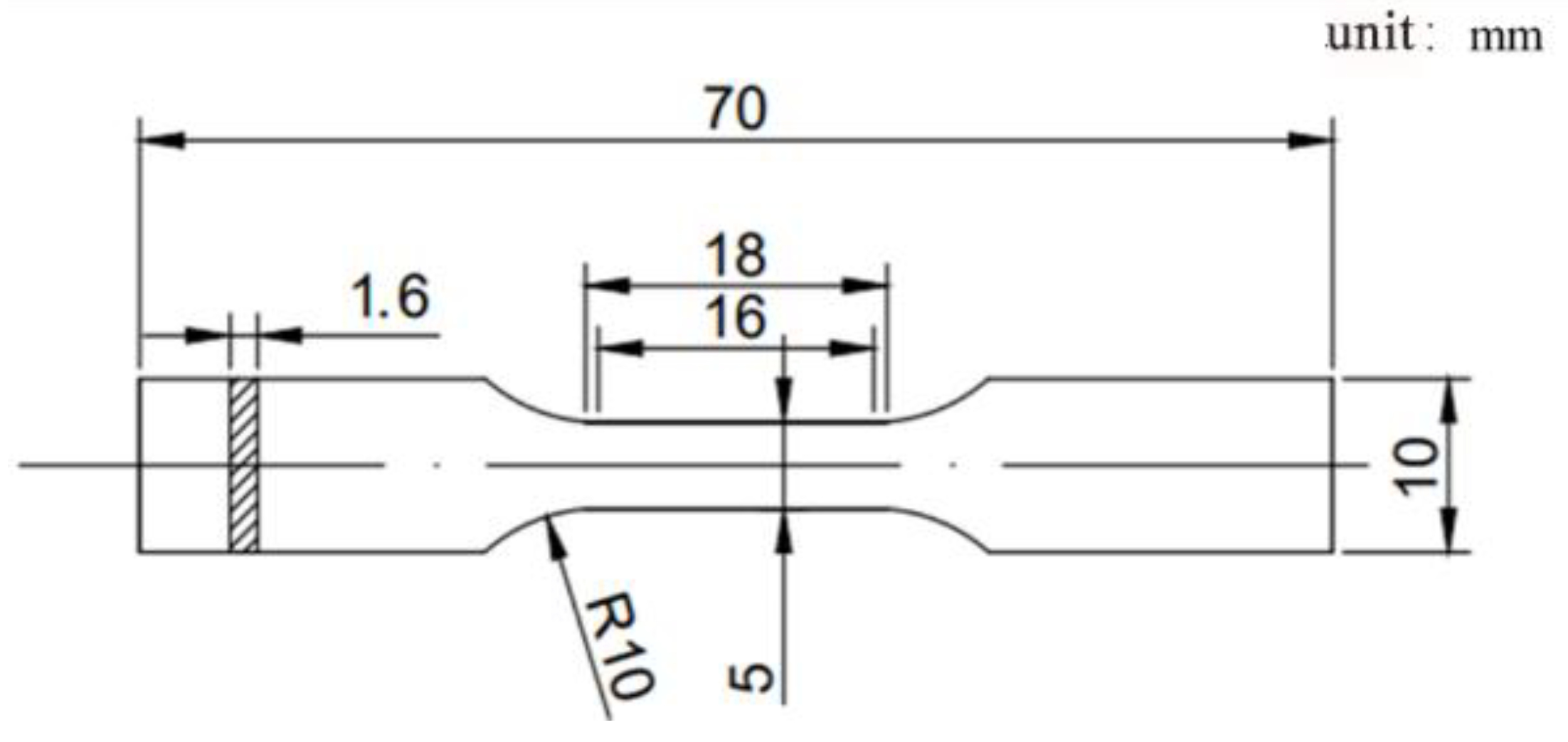
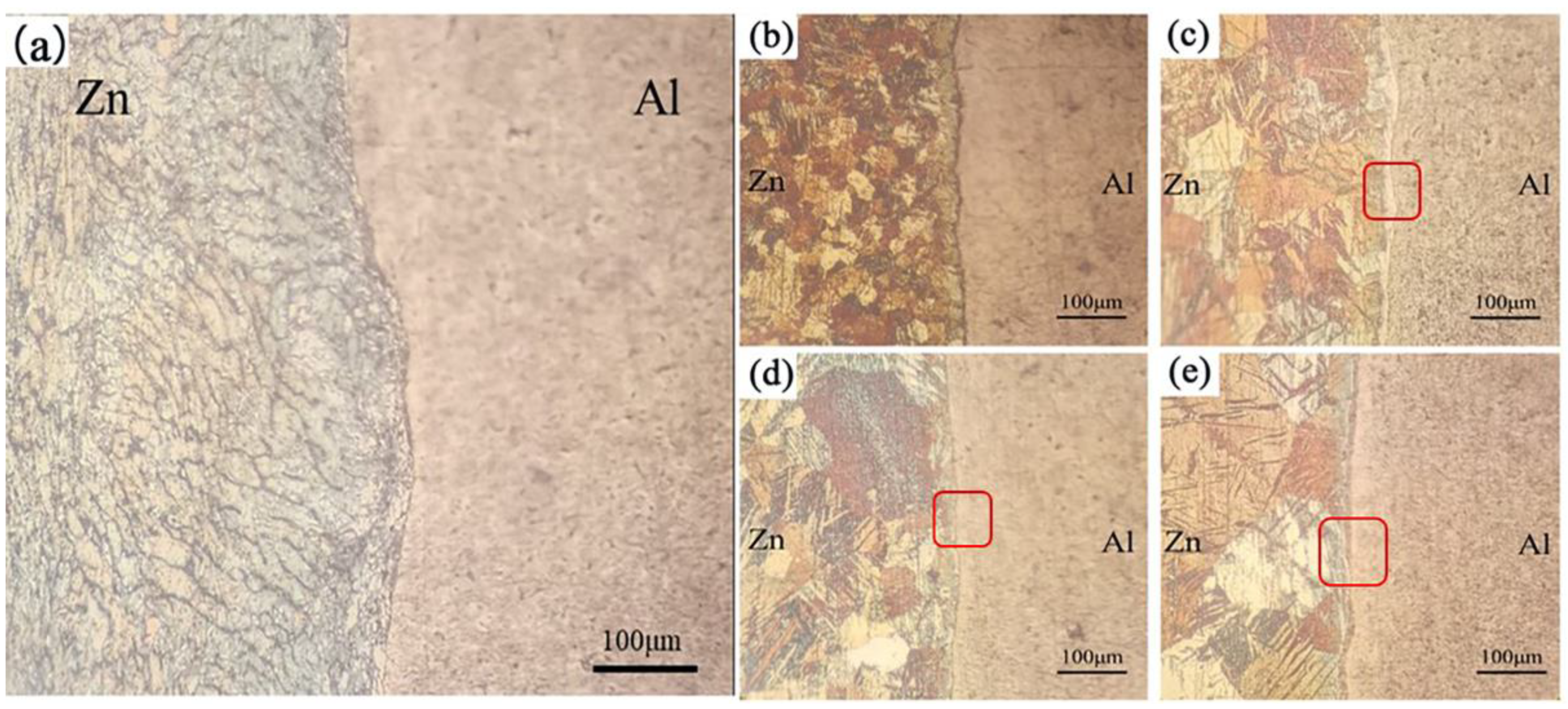


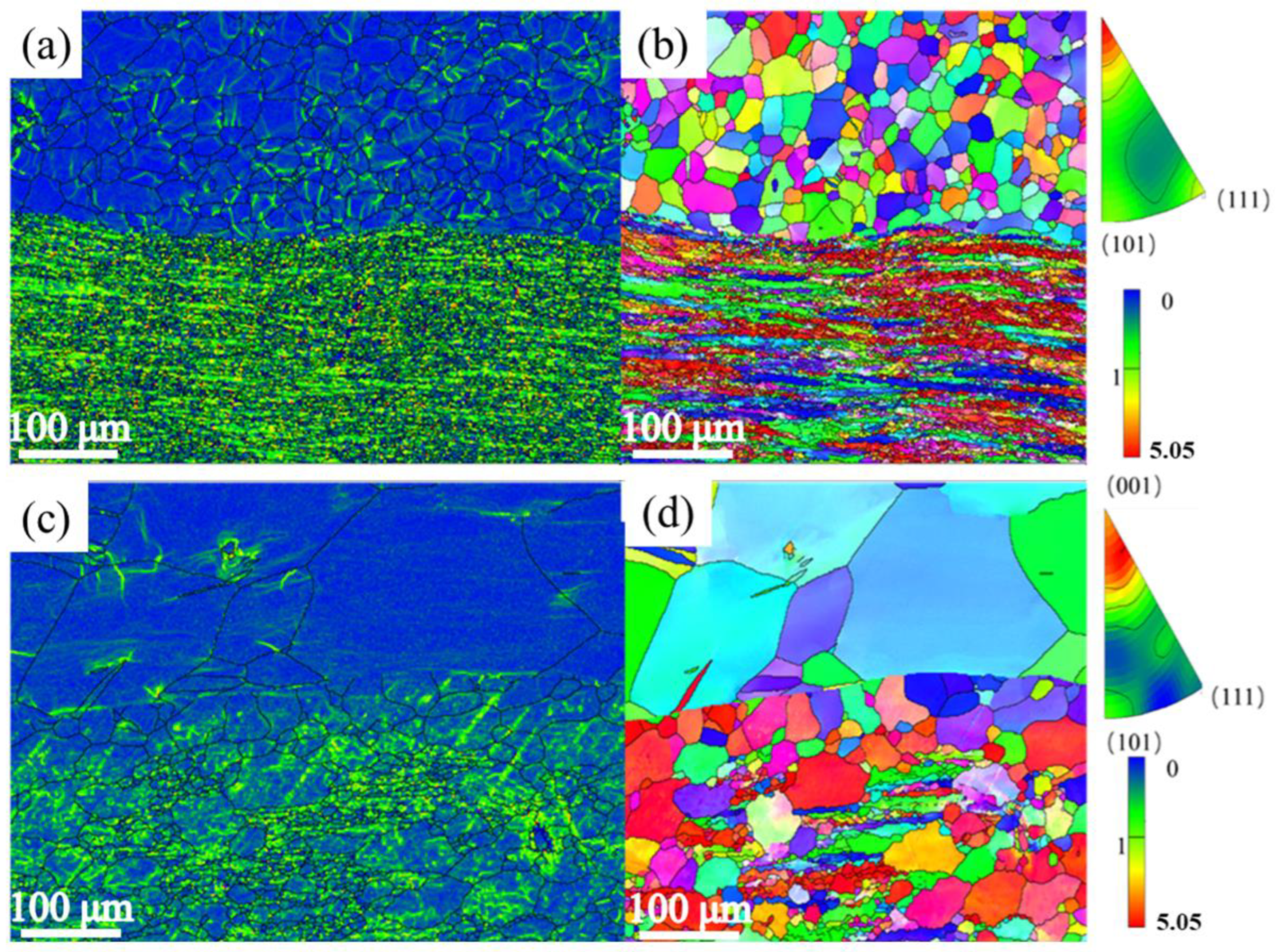

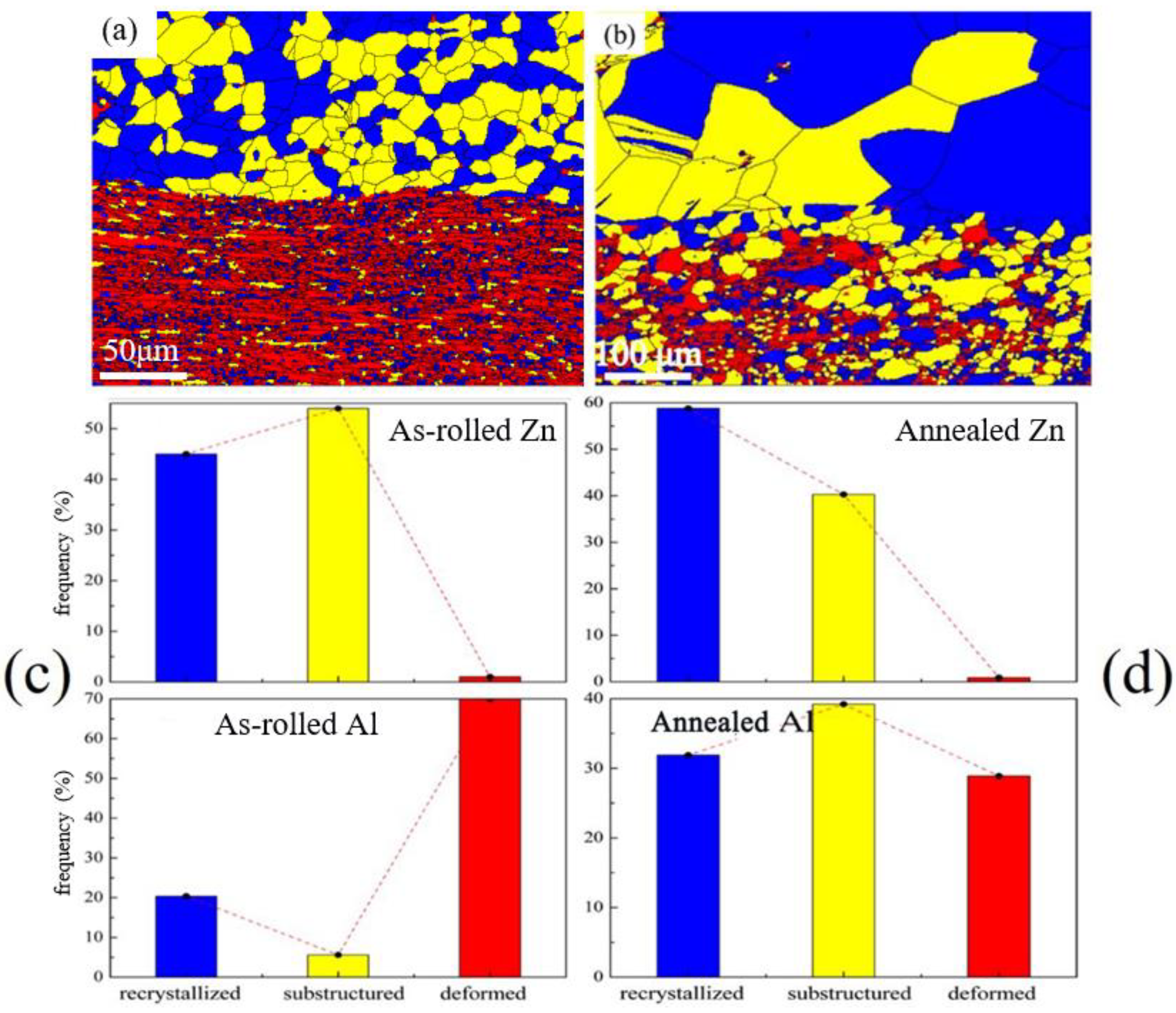
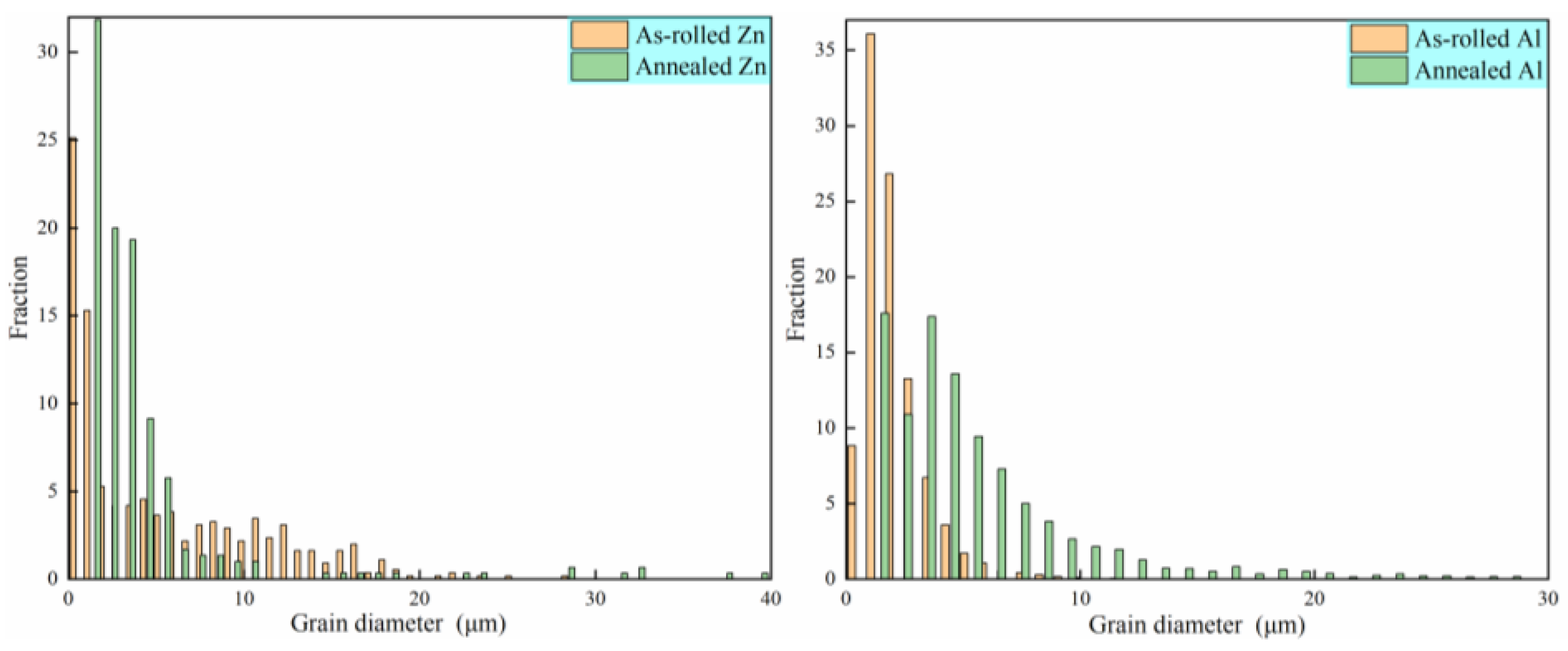


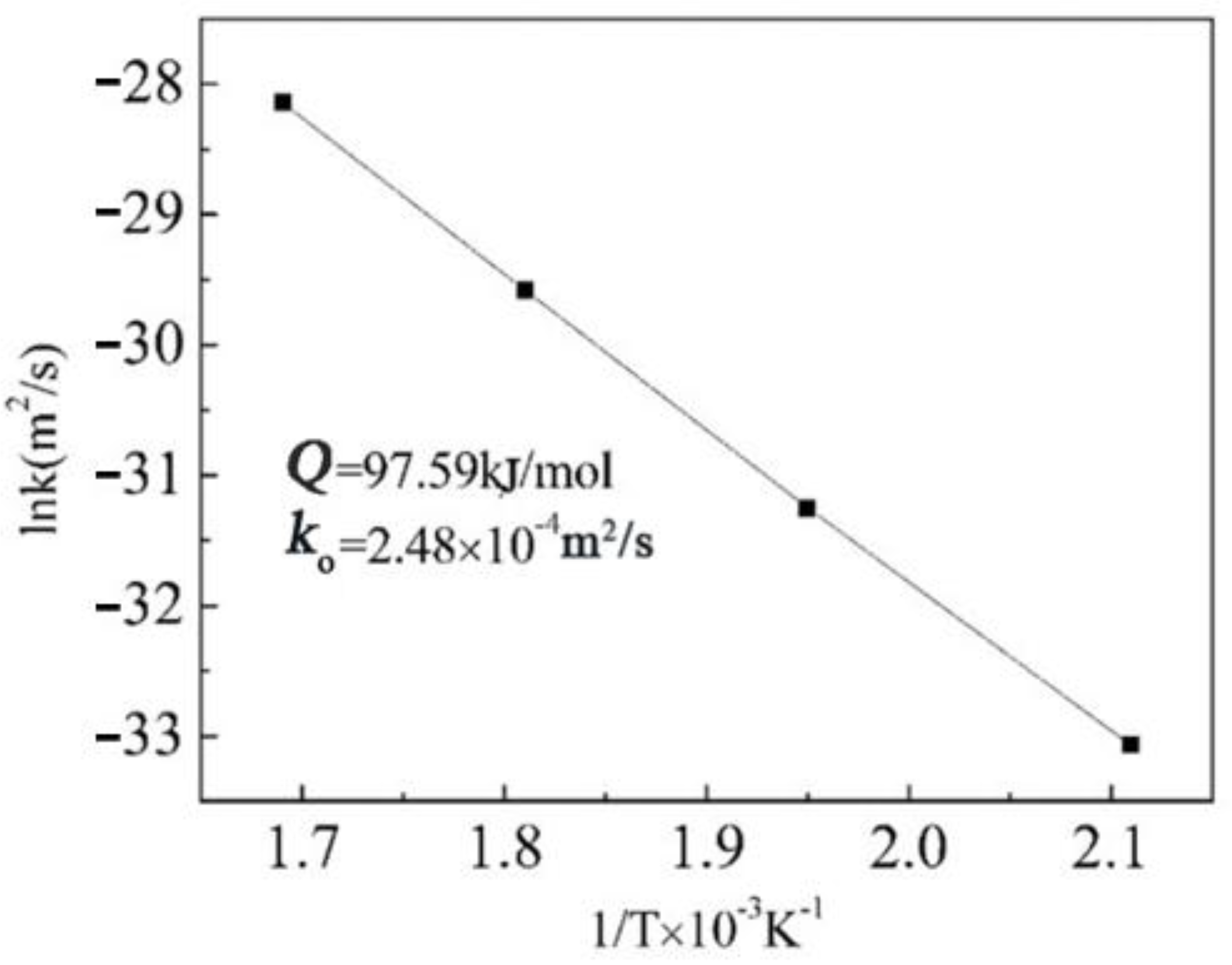
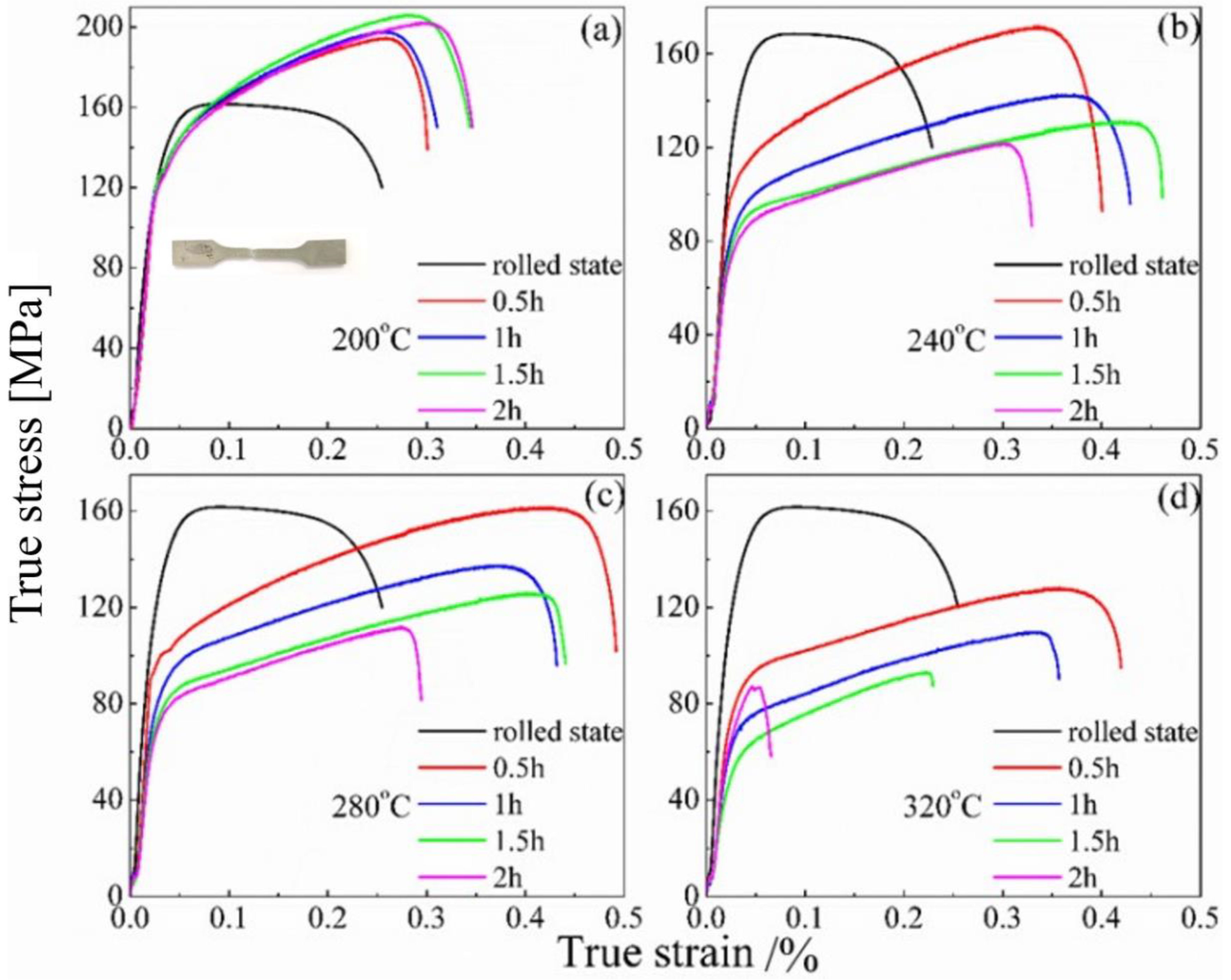
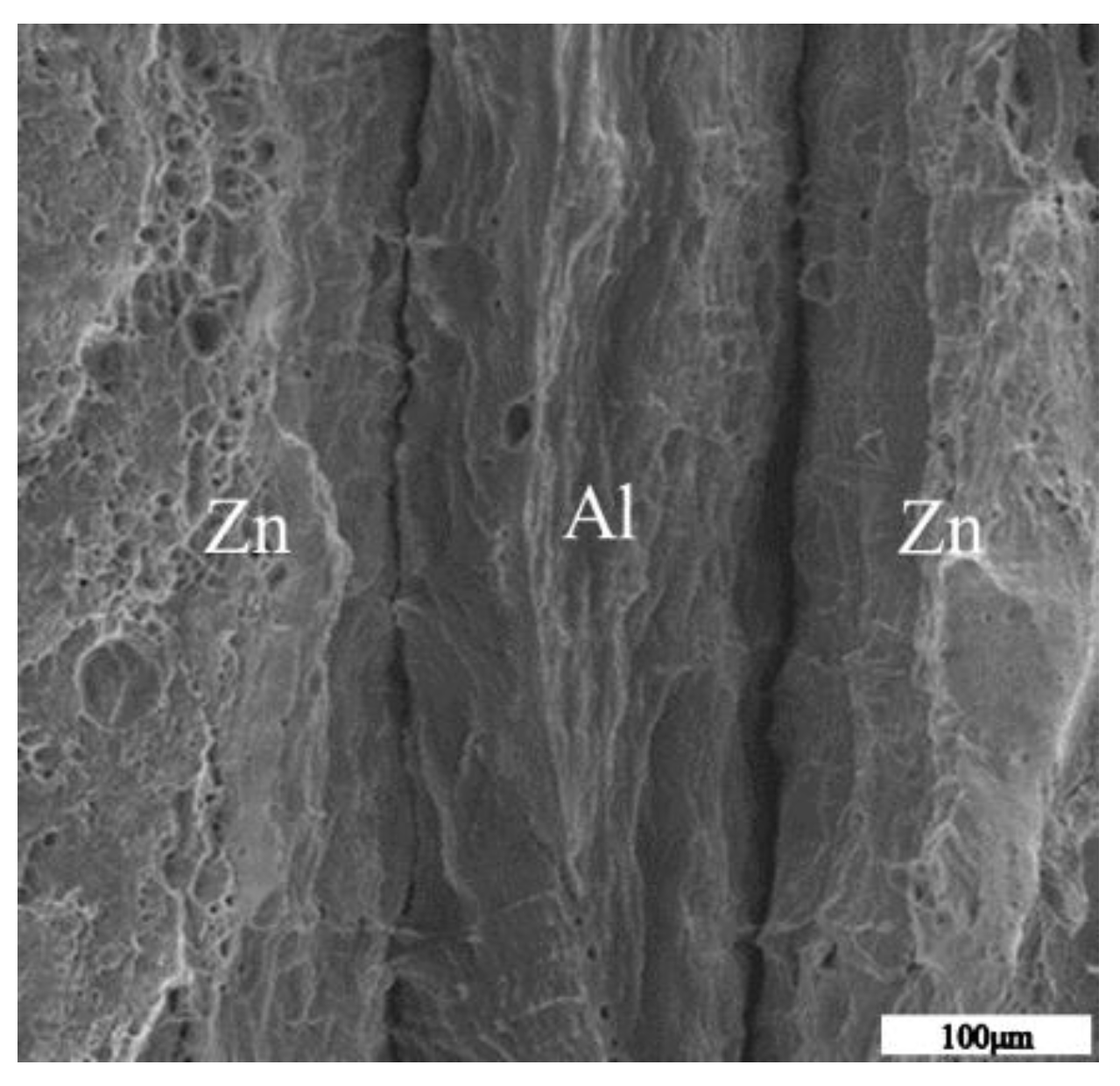
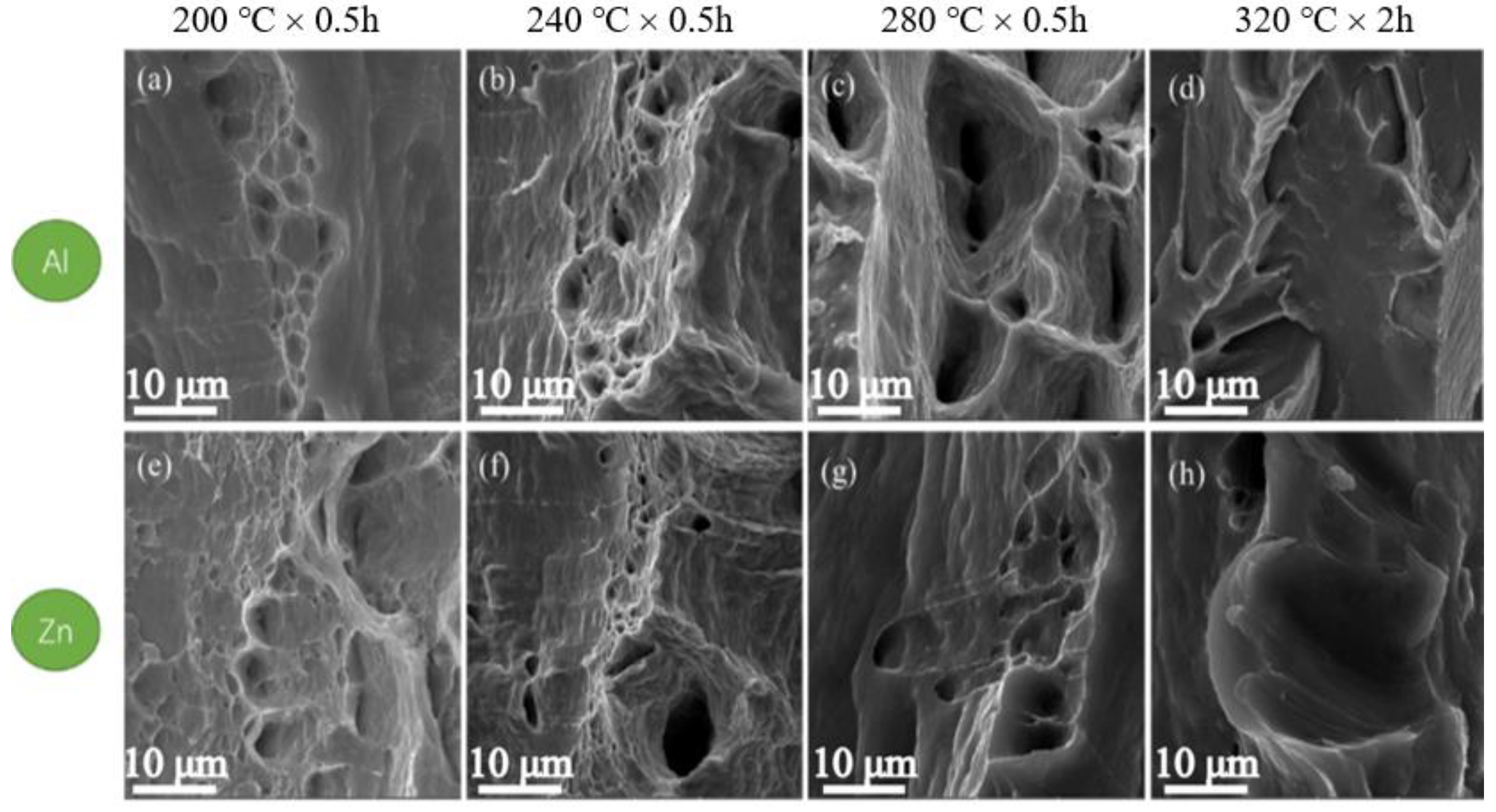

| Material | Al | Si | Zn | Cu | Mn | Mg | Ti | Fe |
|---|---|---|---|---|---|---|---|---|
| Al | ≥99.6 | ≤0.25 | ≤0.05 | ≤0.05 | ≤0.05 | ≤0.05 | ≤0.03 | ≤0.4 |
| Zn | ≤0.001 | / | ≥99.995 | ≤0.001 | / | / | / | ≤0.001 |
| T [°C] | 200 | 240 | 280 | 320 | ||||||||||||
|---|---|---|---|---|---|---|---|---|---|---|---|---|---|---|---|---|
| t [h] | 0.5 | 1.0 | 1.5 | 2.0 | 0.5 | 1.0 | 1.5 | 2.0 | 0.5 | 1.0 | 1.5 | 2.0 | 0.5 | 1.0 | 1.5 | 2.0 |
| Thickness [μm] | 4.0 | 6.0 | 6.5 | 7.0 | 4.0 | 7.9 | 11.2 | 16.0 | 7.1 | 9.5 | 24.0 | 28.0 | 10.7 | 43.0 | 48.0 | 55.0 |
| T [°C] | 200 | 240 | 280 | 320 |
|---|---|---|---|---|
| k [m2/s] | 4.36 × 10−15 | 2.68 × 10−14 | 1.42 × 10−13 | 5.75 × 10−13 |
| T [°C] | T [h] | σs [MPa] | σb [MPa] | Δσb [MPa] | δ/% |
|---|---|---|---|---|---|
| Nonannealed | / | 101.71 | 161.73 | --- | 9.41 |
| 200 | 0.5 | 93.02 | 194.85 | 33.12 | 25.92 |
| 1.0 | 92.92 | 198.04 | 36.31 | 25.69 | |
| 1.5 | 90.76 | 206.15 | 44.42 | 27.83 | |
| 2.0 | 88.57 | 202.48 | 40.75 | 29.37 | |
| 240 | 0.5 | 88.20 | 171.79 | 10.06 | 33.21 |
| 1.0 | 76.17 | 142.82 | −18.91 | 37.25 | |
| 1.5 | 68.95 | 131.27 | −30.46 | 42.22 | |
| 2.0 | 63.89 | 121.74 | −39.99 | 30.59 | |
| 280 | 0.5 | 85.66 | 161.69 | −0.04 | 42.43 |
| 1.0 | 66.04 | 137.50 | −24.23 | 36.32 | |
| 1.5 | 60.58 | 126.18 | −35.55 | 40.05 | |
| 2.0 | 56.75 | 112.15 | −49.58 | 27.35 | |
| 320 | 0.5 | 63.57 | 128.35 | −33.38 | 35.75 |
| 1.0 | 54.40 | 109.92 | −51.81 | 33.34 | |
| 1.5 | 50.60 | 93.35 | −68.38 | 22.29 | |
| 2.0 | 46.99 | 87.43 | −74.3 | 4.62 |
| T/°C | t/h | σsAl/Zn/MPa | σsAl/MPa | σsZn/MPa | σs′Al/Zn/MPa |
|---|---|---|---|---|---|
| 200 | 0.5 | 93.02 | 64.4 | 68.15 | 67.14 |
| 1 | 92.92 | 63.29 | 59.22 | 60.32 | |
| 1.5 | 90.76 | 57.47 | 57.47 | 57.47 | |
| 2 | 88.57 | 52.69 | 52.69 | 52.69 | |
| 240 | 0.5 | 88.2 | 68.03 | 55.04 | 58.54 |
| 1 | 76.17 | 69.38 | 54.28 | 58.35 | |
| 1.5 | 68.95 | 63.01 | 47.78 | 51.89 | |
| 2 | 63.89 | 61.68 | 53.48 | 55.69 | |
| 280 | 0.5 | 85.66 | 83.45 | 51.77 | 60.31 |
| 1 | 66.04 | 68.31 | 52.89 | 57.05 | |
| 1.5 | 60.58 | 70.54 | 53.92 | 58.4 | |
| 2 | 56.75 | 61.33 | 55.36 | 56.97 | |
| 320 | 0.5 | 63.57 | 75 | 55.24 | 60.57 |
| 1 | 54.4 | 76.08 | 53.12 | 59.32 | |
| 1.5 | 50.6 | 69.07 | 50.49 | 55.5 | |
| 2 | 46.99 | 54.16 | 46.35 | 48.46 |
Disclaimer/Publisher’s Note: The statements, opinions and data contained in all publications are solely those of the individual author(s) and contributor(s) and not of MDPI and/or the editor(s). MDPI and/or the editor(s) disclaim responsibility for any injury to people or property resulting from any ideas, methods, instructions or products referred to in the content. |
© 2023 by the authors. Licensee MDPI, Basel, Switzerland. This article is an open access article distributed under the terms and conditions of the Creative Commons Attribution (CC BY) license (https://creativecommons.org/licenses/by/4.0/).
Share and Cite
Wang, R.; Duan, Y.; Peng, M.; Shu, B.; Wang, Y.; Li, M.; Li, C.; Zheng, S.; Qi, H.; Jia, R. Effect of Annealing Process on Interface Behavior of Al/Zn Laminated Composites. Metals 2023, 13, 748. https://doi.org/10.3390/met13040748
Wang R, Duan Y, Peng M, Shu B, Wang Y, Li M, Li C, Zheng S, Qi H, Jia R. Effect of Annealing Process on Interface Behavior of Al/Zn Laminated Composites. Metals. 2023; 13(4):748. https://doi.org/10.3390/met13040748
Chicago/Turabian StyleWang, Renfu, Yonghua Duan, Mingjun Peng, Baipo Shu, Yiren Wang, Mengnie Li, Caiju Li, Shanju Zheng, Huarong Qi, and Ruijiao Jia. 2023. "Effect of Annealing Process on Interface Behavior of Al/Zn Laminated Composites" Metals 13, no. 4: 748. https://doi.org/10.3390/met13040748
APA StyleWang, R., Duan, Y., Peng, M., Shu, B., Wang, Y., Li, M., Li, C., Zheng, S., Qi, H., & Jia, R. (2023). Effect of Annealing Process on Interface Behavior of Al/Zn Laminated Composites. Metals, 13(4), 748. https://doi.org/10.3390/met13040748








